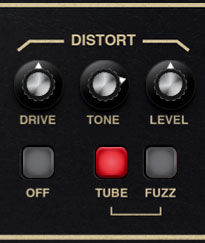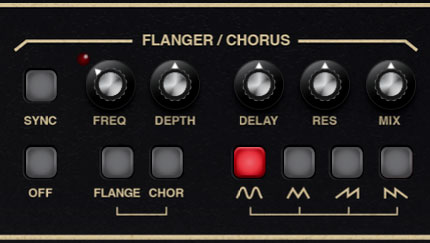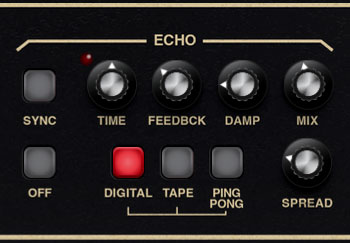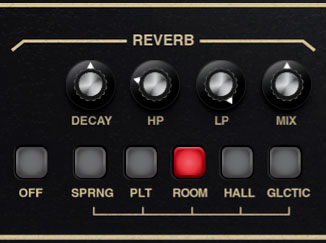
Pro Soloist includes six simultaneous effects: Distortion, Phaser, Flanger/Chorus, Delay, and Reverb. These can be used in any combination.
Global Limiter

Pro Soloist's onboard limiter gently controls overall output level to prevent ugly clipping in case you're playing 16 notes at once with your elbows. It's super transparent, so you can leave it on all the time without detrimentally affecting audio.
Unlike the other effects, it's global, so it affects the entire instrument, and is not independent per layer when using the Double and Split modes.
FX Mode

When set to the Global position, both layers run through a single set of effects. This is useful when you'd like the same effects settings for both layers when creating doubled (layered) or split patches. When set to the Dual Layer position, an entirely independent effects section is available for the upper and lower layers (Layer Control Upper and Lower settings will behave as with all other parameters.)
The FX Mode buttons are only applicable when in Double or Split Layer Mode.
Distort

Drive- Overall amount of distortion.
Tone- Sets the brightness of tone.
Level- Overall volume; this doesn't affect the amount of distortion. Increasing drive will cause an overall volume increase, Level can used to balance things out.
Mode buttons-
Off- Distort effect is disabled.
Tube- Relatively mellow distortion mode. Use it to add just little bit of vintage hair to sounds.
Fuzz- Aggressive and raunchy vintage fuzz tone.
Phaser

Sync- The Sync button locks the rate of the Phaser's modulation LFO to the tempo in the top toolbar when using the Pro Soloist standalone version, or to the current project tempo when the plug-in version is used in a DAW. When engaged, the Freq knob snaps to note values ranging from 1/64th note triplet to 8 beats.
Frequency (Freq)- Sets the phaser's internal LFO speed from 0.01 to 8 Hz. The LED flashes at the current rate
Depth- Sets the effect depth - essentially an amount control.
Res (Resonance)- Increasing the amount of Res intensifies the phasing effect. This is sometimes referred to as "feedback" in other phaser units.
Mode buttons-
Off- Phaser effect is disabled.
2/4/6/8 Stage setting- Who do we appreciate?!? Sorry... Pro Soloist's phaser includes up to 8 stereo all-pass filter stages. As a general rule, more stages = lusher phase, but there are plenty of interesting tones to be had using the lower stage settings.
Flanger/Chorus

We've included a thick and warm flanger/chorus effect. Flanging and Chorus are closely related - the general difference being that flangers use a shorter time range and some amount of feedback (this intensifies the "jet-flyby" whoosh), whereas choruses utilize a slightly longer delay time, and no feedback.
Sync- The Sync button locks the rate of the Flanger/Chorus's modulation LFO to the tempo in the top toolbar when using the Pro Soloist standalone version, or to the current project tempo when the plug-in version is used in a DAW. When engaged, the Freq knob snaps to note values ranging from 1/64th note triplet to 8 beats.
Freq- Sets the phaser's internal LFO speed from 0.01 to 8 Hz.
Mix- Sets the ratio of clean to effected sound. Flanging and chorusing is usually optimal at a 50/50 setting, but we've added the Mix control by popular demand to allow more subtle (or warble-riffic) tones.
Depth- Sets effect depth, i.e. the amount of modulation.
Delay Time- Sets the amount of delay time when in Flanger mode, from 1-13ms.
Res- Sets the amount of internal feedback when in Flange mode.
Mode buttons-
Off- Flanger/Chorus effect is disabled.
Flange- Flange mode is enabled.
Chorus- Chorus mode is enabled. Note that the Delay and Res knobs are disabled when in Chorus mode.
Modulation Waves- Selects the shape of the modulation waveform. Options include sine, triangle, ramp, and sawtooth.
Echo

Sync- The Sync button locks the delay time to master tempo. When engaged, the Time knob snaps to note values ranging from 1/64th note triplet to 8 beats. Sync mode locks to the tempo in the top toolbar when using the Pro Soloist standalone version or the current project tempo when the plug-in version is used in a DAW.
Time- Sets delay time, from 1 to 2000 ms. If the Sync button is enabled, time settings snap to synchronized note values.
Feedback- Routes the output to the input for additional repeats. Be careful at high settings as this can result in runaway feedback madness.
Damp- Attenuates high-frequencies as the knob amount is increased. Not only does this create more natural sounding decays, it also reduces the "stacking" effect that occurs with high feedback levels.
Mix- Sets the ratio of clean to effected sound.
Mode buttons-
Off- Disables Echo effect.
Digital- A pristine sounding digital delay.
Tape- Reproduces the effect of a vintage "space echo" tape delay.
Ping Pong- Echoes alternate between audio channels.
Spread- Alters the left and right channel delay times creating a stereoizing effect. Greater amounts of spread increase the delay time differential and thus the stereo separation.
Reverb

Decay- Sets the length of reverb release time/size of room.
HP- A highpass filter affecting wet reverb signal only. Low frequencies are increasingly attenuated as the knob setting is increased.
LP- A lowpass filter affecting wet reverb signal only. High frequencies are increasingly attenuated as the knob setting is decreased.
Mix- Sets the ratio of clean to effected sound.
Mode buttons-
Off- Disables Reverb effect.
Spring- Recreates mechanical spring-reverb effect often seen (and kicked) in vintage guitar amps.
Plate- A medium-to-large studio plate-style algorithm.
Room- Recreates a vintage algorithmic-style medium room verb.
Hall- A large, hall-style reverb.
Galactic (Glctic)- Cherry Audio's exclusive, giant, spacey reverb.